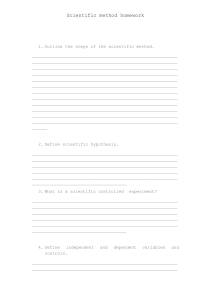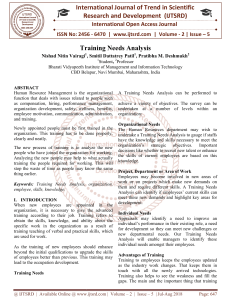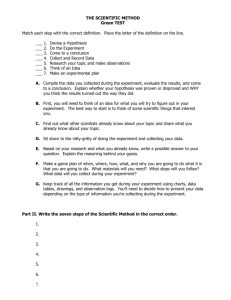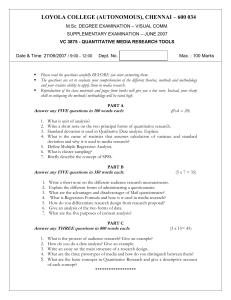Uploaded by
mail
Statistical Methods: Quantitative Techniques in Business
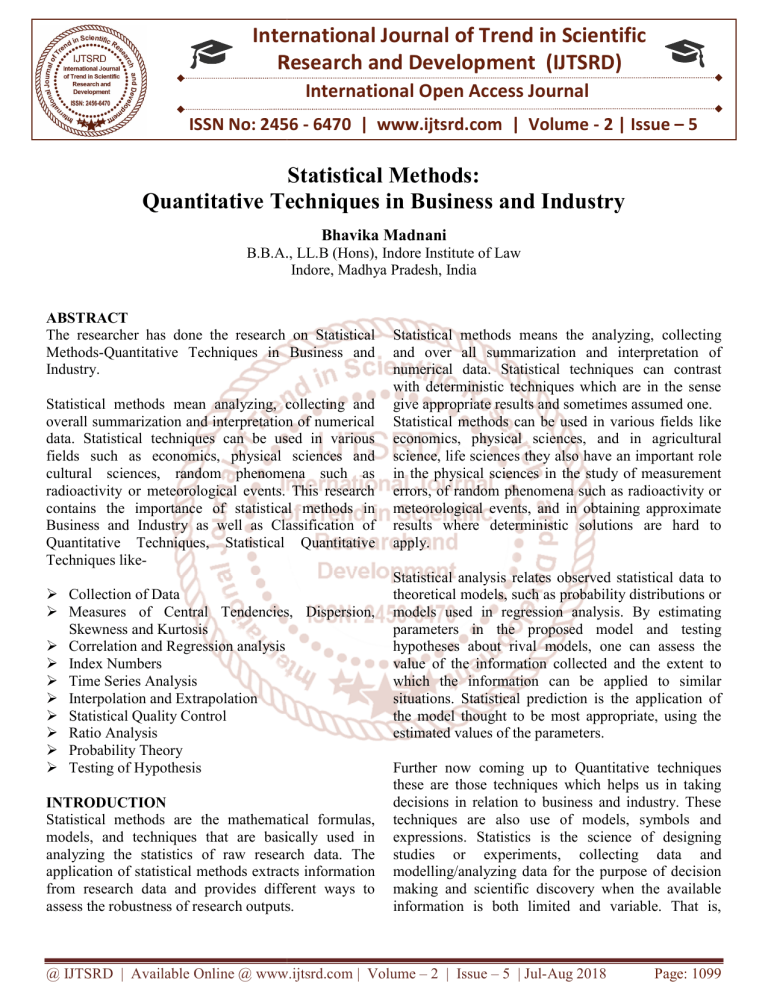
International Journal of Trend in Scientific Research and Development (IJTSRD) International Open Access Journal ISSN No: 2456 - 6470 | www.ijtsrd.com | Volume - 2 | Issue – 5 Statistical Methods: Quantitative Techniques in Business aand nd Industry Bhavika Madnani B.B.A., LL.B (Hons), Indore Institute of Law Indore, Madhya Pradesh, India ABSTRACT The researcher has done the research on Statistical Methods-Quantitative Quantitative Techniques in Business and Industry. Statistical methods mean analyzing, collecting and overall summarization and interpretation of numerical data. Statistical techniques can be used in various fields such as economics, physical ysical sciences and cultural sciences, random phenomena such as radioactivity or meteorological events. This research contains the importance of statistical methods in Business and Industry as well as Classification of Quantitative Techniques, Statistical Quantitative Techniques like Collection of Data Measures of Central Tendencies, Dispersion, Skewness and Kurtosis Correlation and Regression analysis Index Numbers Time Series Analysis Interpolation and Extrapolation Statistical Quality Control Ratio Analysis Probability Theory Testing of Hypothesis INTRODUCTION Statistical methods are the mathematical formulas, models, and techniques that are basically used in analyzing the statistics of raw research data. The application of statistical methods extracts cts information from research data and provides different ways to assess the robustness of research outputs. Statistical methods means the analyzing, collecting and over all summarization and interpretation of numerical data. Statistical techniques can contrast with deterministic techniques which are in the sense give appropriate results and sometimes assumed one. Statistical methods can be used in various fields like economics, physical sciences, and in agricultural science, life sciences they also have an important role in the physical sciences in the study of measurement errors, of random phenomena such as radioactivity or meteorological events, and in obtaining approximate results where deterministic solutions are hard to apply. Statistical analysis relates observed statistical data to theoretical models, such as probability distributions or models used in regression analysis. By estimating parameters in the proposed model and testing hypotheses about rival models, one can assess the value of the information rmation collected and the extent to which the information can be applied to similar situations. Statistical prediction is the application of the model thought to be most appropriate, using the estimated values of the parameters. Further now coming up to Quantitative techniques these are those techniques which helps us in taking decisions in relation to business and industry. These techniques are also use of models, symbols and expressions. Statistics is the science of designing studies or experiments, collecting col data and modelling/analyzing data for the purpose of decision making and scientific discovery when the available information is both limited and variable. That is, @ IJTSRD | Available Online @ www.ijtsrd.com | Volume – 2 | Issue – 5 | Jul-Aug Aug 2018 Page: 1099 International Journal of Trend in Scientific Research and Development (IJTSRD) ISSN: 2456-6470 statistics is the science of Learning from Data. Almost everyone—including corporate presidents, marketing representatives, social scientists, engineers, medical researchers, and consumers—deals with data. These data could be in the form of quarterly sales figures, percent increase in juvenile crime, contamination levels in water samples, survival rates for patients undergoing medical therapy, census figures, or information that helps determine which brand of car to purchase. In this text, we approach the study of statistics by considering the four-step process in Learning from Data: (1) defining the problem, (2) collecting the data, (3) summarizing the data, and (4) analyzing data, interpreting the analyses, and communicating results. Through the use of these four steps in Learning from Data, our study of statistics closely parallels the Scientific Method, which is a set of principles and procedures used by successful scientists in their pursuit of knowledge. The method involves the formulation of research goals, the design of observational studies and/or experiments, the collection of data, the modeling/ analyzing of the data in the context of research goals, and the testing of hypotheses. The conclusions of these steps is often the formulation of new research goals for another study you must remember that for each data set requiring analysis, someone has defined the problem to be examined (Step 1), developed a plan for collecting data to address the problem (Step 2), and summarized the data and prepared the data for analysis (Step 3). Then following the analysis of the data, the results of the analysis must be interpreted and communicated either verbally or in written form to the intended audience (Step 4).We can think of many reasons for taking an introductory course in statistics. One reason is that you need to know how to evaluate published numerical facts. Every person is exposed to manufacturers’ claims for products; to the results of sociological, consumer, and political polls; and to the published results of scientific research. Many of these results are inferences based on sampling. Some inferences are valid; others are invalid. Some are based on samples of adequate size; others are not. Yet all these published results bear the ring of truth. Some people (particularly statisticians) say that statistics can be made to support almost anything. Others say it is easy to lie with statistics. Both statements are true. It is easy, purposely or unwittingly, to distort the truth by using statistics when presenting the results of sampling to the uninformed. It is thus crucial that you become an informed and critical reader of data-based reports and articles. A second reason for studying statistics is that your profession or employment may require you to interpret the results of sampling (surveys or experimentation) or to employ statistical methods of analysis to make inferences in your work. For example, practicing physicians receive large amounts of advertising describing the benefits of new drugs. These advertisements frequently display the numerical results of experiments that compare a new drug with an older one. Do such data really imply that the new drug is more effective, or is the observed difference in results due simply to random variation in the experimental measurements? Recent trends in the conduct of court trials indicate an increasing use of probability and statistical inference in evaluating the quality of evidence. The use of statistics in the social, biological, and physical sciences is essential because all these sciences make use of observations of natural phenomena, through sample surveys or experimentation, to develop and test new theories. Statistical methods are employed in business when sample data are used to forecast sales and profit. In addition, they are used in engineering and manufacturing to monitor product quality. The sampling of accounts is a useful tool to assist accountants in conducting audits. Thus, statistics plays an important role in almost all areas of science, business, and industry; persons employed in these areas need to know the basic concepts, strengths, and limitations of statistics. The development and testing of the Salk vaccine for protection against poliomyelitis (polio) provide an excellent example of how statistics can be used in solving practical problems. Most parents and children growing up before 1954 can recall the panic brought on by the outbreak of polio cases during the summer months. Although relatively few children fell victim to the disease each year, the pattern of outbreak of polio was unpredictable and caused great concern because of the possibility of paralysis or death. The fact that very few of today’s youth have even heard of polio demonstrates the great success of the vaccine and the testing program that preceded its release on the market. It is standard practice in establishing the effectiveness of a particular drug product to conduct an experiment (often called a clinical trial) with human participants. For some clinical trials, assignments of participants are made at random, with half receiving the drug product and the other half receiving a solution or tablet that does not contain the medication (called a placebo). One statistical problem concerns the determination of the total number of participants to be included in theclinical trial. This @ IJTSRD | Available Online @ www.ijtsrd.com | Volume – 2 | Issue – 5 | Jul-Aug 2018 Page: 1100 International Journal of Trend in Scientific Research and Development (IJTSRD) ISSN: 2456-6470 problem was particularly important in the testing of the Salk vaccine because data from previous years suggested that the incidence rate for polio might be less than 50 cases for every 100,000 children. Hence, a large number of participants had to be included in the clinical trial in order to detect a difference in the incidence rates for those treated with the vaccine and those receiving the placebo. Libel suits related to consumer products have touched each one of us; you may have been involved as a plaintiff or defendant in a suit or you may know of someone who was involved in such litigation. Certainly we all help to fund the costs of this litigation indirectly through increased insurance premiums and increased costs of goods. The testimony in libel suits concerning a particular product (automobile, drug product, and so on) frequently leans heavily on the interpretation of data from one or more scientific studies involving the product. This is how and why statistics and statisticians have been pulled into the courtroom. For example, epidemiologists have used statistical concepts applied to data to determine whether there is a statistical “association’’ between a specific characteristic, such as the leakage in silicone breast implants, and a disease condition, such as an autoimmune disease. An epidemiologist who finds an association should try to determine whether the observed statistical association from the study is due to random variation or whether it reflects an actual association between the characteristic and the disease. Courtroom arguments about the interpretations of these types of associations involve data analyses using statistical concepts as well as a clinical interpretation of the data. Many other examples exist in which statistical models are used in court cases. In salary discrimination cases, a lawsuit is filed claiming that an employer underpays employees on the basis of age, ethnicity, or sex. Statistical models are developed to explain salary differences based on many factors, such as work experience, years of education, and work performance. These techniques can be grouped in two categories: Statistical Techniques; and Operations Research(or programming techniques) In this research I am going to give brief description mainly about the Statistical techniques which includes: Measures of Central Tendencies, Dispersion, Skewness and Kurtosis Correlation and Regression analysis Index Numbers Time Series Analysis Interpolation and Extrapolation Statistical Quality Control Ratio Analysis Probability Theory Testing of Hypothesis IMPORTANCE OF STATISTICAL METHODS IN BUSINESS AND INDUSTRY Role of statistics in BUSINESS and INDUSTRY Statistics plays a vital and essential role in every business man’s life. A businessman makes his strategies, policies, decides about his programmes keeping in view the graphical readings of the people’s tastes and preferences, changing culture and much more, quality of the products can also be checked by using statistical methods. MANAGEMENT Marketing: Product selection Analysis of marketing research information Statistical records for building and maintain an extensive market. Competitive strategies Sales forecasting Advertising strategy Production: Production planning, control and analysis Allocation of Resources Evaluation of machine performance Location of factories and their sizes Quality control requirements Equipment replacement and maintenance Inventory control measures Finance, Accounting and Investment: Financial forecast, budget preparation Financial investment decisions Selection of securities Auditing function Credit policies, credit risk and delinquent accounts. Collection of Data @ IJTSRD | Available Online @ www.ijtsrd.com | Volume – 2 | Issue – 5 | Jul-Aug 2018 Page: 1101 International Journal of Trend in Scientific Research and Development (IJTSRD) ISSN: 2456-6470 CLASSIFICATION OF QUANTITATIVE TECHNIQUES Quantitative techniques can be classified into Statistical Techniques (or Statistical methods and measure) and Programming Techniques (or Operation Research) Statistical Techniques: I. Methods of collecting data II. Classification and tabulation of collected data III. Probability theory and Sampling Analysis IV. Correlation and Regression Analysis V. Index Numbers VI. Time Series Analysis VII. Interpolation and Extrapolation VIII. Survey Techniques and Methodology IX. Ratio Analysis X. Statistical Quality Control XI. Analysis of Variance XII. Statistical Interference and Interpretation XIII. Theory of Attributes XIV. Curve Fitting and Method of Least square Programming Techniques: I. Linear Programming II. Decision Theory III. Theory of Games IV. Simulation V. Monte Carlo Technique VI. System Simulation VII. Queuing Theory VIII. Inventory Planning IX. Network Analysis/ PERT X. Integrated Production Models that may lead to credible and conclusive answers to questions that have been posed. Accurate data collection is essential to ensure the integrity of the research, regardless of the field of study or data preference (quantitative or qualitative). The selection of appropriate data collection tools and instruments, which may be existing, modified or totally new, and with clearly defined instructions for their proper use, reduces the chances of errors occurring during collection. This is the most integral and essential part of collection of any kind of information in the research prospectus usually done in any field such as industry, business, humanities, social sciences or other physical sciences. There are basically two methods of collection of data particularly PRIMARY DATA and SECONDARY DATA. PRIMARY DATA When we obtain data directly from individuals, objects or processes, we refer to it as primary data. Quantitative or qualitative data can be collected using this approach. Such data is usually collected solely for the research problem to you will study. Primary data has several advantages. First, we tailor it to our specific research question, so there are no customizations needed to make the data usable. Second, primary data is reliable because you control how the data is collected and can monitor its quality. Third, by collecting primary data, you spend your resources in collecting only required data. Finally, primary data is proprietary, so you enjoy advantages over those who cannot access the data. STATISTICAL QUANTITATIVE TECHNIQUES 1. COLLECTION OF DATA One of the most important data is collection of data. Data collection is the process of gathering and collecting data, information and any variables of interest in a standardized and a well established manner that enables to collect the answer and evaluates outcome of the particular collection. Data collection is concerned with the accurate acquisition of data; although methods may differ depending on the field, the emphasis on ensuring accuracy remains the same. The primary goal of any data collection endeavour is to capture quality data or evidence that easily translates to rich data analysis SECONDARY DATA When you collect data after another researcher or agency that initially gathered it makes it available, you are gathering secondary data. Examples of secondary data are census data published by the US Census Bureau, stock prices data published by CNN and salaries data published by the Bureau of Labor Statistics. One advantage to using secondary data is that it will save you time and money, although some data sets require you to pay for access. A second advantage is the relative ease with which you can obtain it. You can easily access secondary data from publications, government agencies, data aggregation websites and blogs. A third advantage is that it eliminates effort @ IJTSRD | Available Online @ www.ijtsrd.com | Volume – 2 | Issue – 5 | Jul-Aug 2018 Page: 1102 International Journal of Trend in Scientific Research and Development (IJTSRD) ISSN: 2456-6470 duplication since you can identify existing data that matches your needs instead of gather new data. index number is usually expressed as 100 times the ratio to the base value. MEASURES OF CENTRAL TENDENCY, DISPERSION, SKEWNESS AND KURTOSIS Measures of Central tendency are a method use for finding the average of a series while Measures of dispersion used for finding out the variability in a series. Measures of Skewness measures asymmetry of a distribution while measures of kurtosis measures the flatness of peakedness in a distribution. Index numbers are values expressed as a percentage of a single base figure. For example, if annual production of a particular chemical rose by 35%, output in the second year was 135% of that in the first year. In index terms, output in the two years was 100 and 135 respectively. CORRELATION AND REGRESSION ANALYSIS In this method first we will discuss about the correlation analysis which means that it is used to quantify the association between two continuous variables that is either between one dependent and the other independent variable or both the independent variables. Two or more variables are said to be interlinked or correlated if the change in one variable results in the change of another variable. According to Simpson and Kafka, “Correlation analysis attempts to determine the degree of relationship between variables”. Boddingtons states that “Whenever some definite connection exists between two or more groups or classes of series of data, there is said to be correlation.” Regression analysis is a related technique to assess the relationship between an outcome variable and one or more risk factors or confounding variables. The outcome variable is also called the response or dependent variable and the risk factors and confounders are called the predictors, or explanatory or independent variables. In regression analysis, the dependent variable is denoted "y" and the independent variables are denoted by "x". INDEX NUMBERS Index numbers measure the fluctuations in various Phenomena like price, production etc over a period of time, they are described as economic barametres. An index number is an economic data figure reflecting price or quantity compared with a standard or base value. The base usually equals 100 and the TIME SERIES ANALYSIS Analysis of time series helps us to know the effect of factors which are responsible for changes. A time series is a series of data points indexed in time order. Most commonly, a time series is a sequence taken at successive equally spaced points in time. Thus it is a sequence of discrete-time data. A time series is a series of data points indexed (or listed or graphed) in time order. Most commonly, a time series is a sequence taken at successive equally spaced points in time. Thus it is a sequence of discrete-time data. Examples of time series are heights of ocean tides, counts of sunspots, and the daily closing value of the Dow Jones Industrial Average. Time series are very frequently plotted via line charts. Time series are used in statistics, signal processing, pattern recognition, econometrics, mathematical finance, weather forecasting, earthquake prediction, electroencephalography, control engineering, astronomy, communications engineering, and largely in any domain of applied science and engineering which involves temporal measurements. INTERPOLATION AND EXTRAPOLATION Interpolation is the statistical technique of estimating under certain assumptions, the missing figures which may fall within the range of given figures. Extrapolation provides estimated figures outside the range of given data. Interpolation is an estimation of a value within two known values in a sequence of values. Polynomial interpolation is a method of estimating values between known data points. When graphical data contains a gap, but data is available on either side of the gap or at a few specific points within the gap, interpolation allows us to estimate the values within the gap. @ IJTSRD | Available Online @ www.ijtsrd.com | Volume – 2 | Issue – 5 | Jul-Aug 2018 Page: 1103 International Journal of Trend in Scientific Research and Development (IJTSRD) ISSN: 2456-6470 Extrapolation is an estimation of a value based on extending a known sequence of values or facts beyond the area that is certainly known. In a general sense, to extrapolate is to infer something that is not explicitly stated from existing information. STATISTICAL QUALITY CONTROL Statistical quality control is used for ensuring the quality of items manufactured. The variations in quality because of assignable causes and chance causes can be known with the help of this tool. Different control charts are used in controlling the quality of products. Statistical quality control refers to the use of statistical methods in the monitoring and maintaining of the quality of products and services. One method, referred to as acceptance sampling, can be used when a decision must be made to accept or reject a group of parts or items based on the quality found in a sample. A second method, referred to as statistical process control, uses graphical displays known as control charts to determine whether a process should be continued or should be adjusted to achieve the desired quality. TOOLS USED FOR STATISTICAL QUALITY CONTROL Every process depends on gathering and analysis of data what are profuse in any organization that is involved in the process problem. The basic tools are: Data Collection Data Display Data Collection A check sheet is useful in assembling and compiling data concerning a problem. It uses for data collection to view for any unwanted element. The functions of a check sheet are I. Production process distribution checks II. Defective item checks III. Defect location checks IV. Defect cause checks V. Checkup confirmation checks Data Display When a company collects data it is converted on to various types of charts and forms for the purpose of display and analysis of data. Charts have different types as: I. A bar graph (present simple data and easy understood) II. A scatter diagram (relationship between two types of data) III. A histogram (distribution of data in term of frequency) IV. A Pareto diagram (statistical tool in problem analysis) RATIO ANALYSIS Ratio Analysis is used for analyzing financial statements of any business or industrial concerns which help to take appropriate decisions. A ratio analysis is a quantitative analysis of information contained in a company’s financial statements. Ratio analysis is used to evaluate various aspects of a company’s operating and financial performance such as its efficiency, liquidity, profitability and solvency. Ratio Analysis is a form of Financial Statement Analysis that is used to obtain a quick indication of a firm's financial performance in several key areas. The ratios are categorized as Short-term Solvency Ratios, Debt Management Ratios, Asset Management Ratios, Profitability Ratios, and Market Value Ratios. Ratio Analysis as a tool possesses several important features. The data, which are provided by financial statements, are readily available. The computation of ratios facilitates the comparison of firms which differ in size. Ratios can be used to compare a firm's financial performance with industry averages. In addition, ratios can be used in a form of trend analysis to identify areas where performance has improved or deteriorated over time. Because Ratio Analysis is based upon accounting information, its effectiveness is limited by the distortions which arise in financial statements due to such things as Historical Cost Accounting and inflation. Therefore, Ratio Analysis should only be used as a first step in financial analysis, to obtain a quick indication of a firm's performance and to identify areas which need to be investigated further. PROBABILITY THEORY Theory of probability provides numerical values of the likely hood of the occurrence of events. A technique used by risk managers for forecasting future events, such as accidental and business losses. This process involves a review of historical loss data to @ IJTSRD | Available Online @ www.ijtsrd.com | Volume – 2 | Issue – 5 | Jul-Aug 2018 Page: 1104 International Journal of Trend in Scientific Research and Development (IJTSRD) ISSN: 2456-6470 calculate a probability distribution that can be used to predict future losses. The probability analyst views past losses as a range of outcomes of what might be expected for the future and assumes that the environment will remain fairly stable. This technique is particularly effective for companies that have a large amount of data on past losses and that have experienced stable operations. This type of analysis is contrasted to trend analysis. Probability bounds analysis (PBA) is a collection of methods of uncertainty propagation for making qualitative and quantitative calculations in the face of uncertainties of various kinds. It is used to project partial information about random variables and other quantities through mathematical expressions. In analysis of algorithms, probabilistic analysis of algorithms is an approach to estimate the computational complexity of an algorithm or a computational problem. This assumption is then used to design an efficient algorithm or to derive the complexity of a known algorithm. TESTING OF HYPOTHESIS Testing of hypothesis is an important statistical tool to judge the reliability of inferences drawn on the basis of sample studies. A statistical hypothesis, sometimes called confirmatory data analysis, is a hypothesis that is testable on the basis of observing a process that is modelled via a set of random variables.[1] A statistical hypothesis test is a method of statistical inference. Commonly, two statistical data sets are compared, or a data set obtained by sampling is compared against a synthetic data set from an idealized model. A hypothesis is proposed for the statistical relationship between the two data sets, and this is compared as an alternative to an idealized null hypothesis that proposes no relationship between two data sets. CONCLUSION In this web page we outlined the broad areas in which the Institute of Statistical Mathematics takes part. We hope that you now understand that the activities of the Institute of Statistical Mathematics extend over into the entire realm of science and culture. Today, in the information age, an immense amount of data is being accumulated in every aspect of society. These data will be useful only when we can pick out effective information from them. In the near future, statistical methods, which aim at putting data and information to practical use, will become increasingly valuable not only in the areas of science and industry, but also in public administration. The Institute of Statistical Mathematics is making efforts to both develop theory for this and extend the range of application. We are advancing the development of statistics, the basis of science and culture. Statistical analysis relates observed statistical data to theoretical models, such as probability distributions or models used in regression analysis. By estimating parameters in the proposed model and testing hypotheses about rival models, one can assess the value of the information collected and the extent to which the information can be applied to similar situations. Statistical prediction is the application of the model thought to be most appropriate, using the estimated values of the parameters. @ IJTSRD | Available Online @ www.ijtsrd.com | Volume – 2 | Issue – 5 | Jul-Aug 2018 Page: 1105
